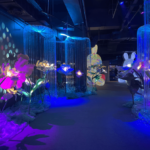
Sidney Felsen, the co-founder of the groundbreaking Los Angeles printmaking studio Gemini GEL, has died. The cause of death was renal failure. Felsen was 99 years old.
Along with co-founder Stanley Grinstein—who died in 2014—Felsen founded Gemini GEL in 1966, and he continued to manage the business, coming into the office nearly every day, until roughly a month before his death. Considered to be one of the most innovative printmaking studios in the history of American art, Gemini’s early decades included collaborations with Josef Albers, Jasper Johns, Ellsworth Kelly, Roy Lichtenstein, Claes Oldenburg, Robert Rauschenberg and Frank Stella, among others, and more recent years saw frequent collaborations with John Baldessari, Cecily Brown, Bruce Nauman, Julie Mehretu and many more.

Sidney B. Felsen, Self‐portrait with two Ellsworth Kellys, 1984, Getty Research Institute, Los Angeles Gift of Jack Shear. Photo © J. Paul Getty Trust.
Many of the artists who collaborated with Gemini—including Ed Ruscha and Richard Serra—worked with the studio for more than 40 years, producing large bodies of their work in the process. Felsen was also an amateur photographer known for his love of documenting the artists with whom he worked, and in 2019 his archive of more than 70,000 photographs was donated to the Getty Research Institute by Jack Shear, husband of the late Ellsworth Kelly, and a selection these photographs is currently on view in an exhibition at the Getty Center in Los Angeles titled First Came a Friendship: Sidney B. Felsen and the Artists at Gemini GEL.
Felsen was born in Chicago in 1924. His parents ran a grocery store, and the family moved to Los Angeles when Felsen was 14. Felsen attended Fairfax High School, a few short blocks east of the eventual location of Gemini, and after a stint in the army, he returned to Los Angeles to study accounting at the University of Southern California (USC).

Sidney B. Felsen, Richard Serra during the proofing of his series Rounds in the Gemini artist studio, 1998, Getty Research Institute, Los Angeles Gift of Jack Shear. Photo © J. Paul Getty Trust
Though he worked as an accountant after graduating, he took night classes in painting and ceramics, and had pursued photography ever since receiving a Kodak Retina camera as a bar mitzvah gift in the 1930s. In 1966, Felsen and his fellow USC fraternity brother Stanley Grinstein, who was then working as a lawyer, set out to open what would become Gemini GEL. The two bought into a printmaking shop run by master lithographer Kenneth Tyler that at the time was known as Gemini Limited. The three changed the name to Gemini GEL (the acronym standing for Graphic Editions Limited) and Tyler stayed on until 1974.
“It was innocence,” Felsen told The Los Angeles Times in a 2016 interview. “We thought it was gonna be a hobby, that it would be fun to hang around the artists, maybe build up a collection.”

Sidney B. Felsen, Julie Mehretu working on Mylar for her etching Auguries, 2010, Getty Research Institute, Los Angeles Gift of Jack Shear. Photo © J. Paul Getty Trust.
In the business’s first year, the three co-founders began pursuing Abstract Expressionists to produce editions, including reaching out to Mark Rothko and Willem de Kooning, but, as Felsen put it, “none of them came, they didn’t want to make prints”. Tyler had a connection to Josef Albers, who agreed to produce a series of lithographs with Gemini, and when Man Ray was in town for his 1966 retrospective at the Los Angeles County Museum of Art (Lacma), he also produced a series of prints with the printshop.
The following year, Robert Rauschenberg tasked Gemini with producing his work Booster, a six-foot-tall print that involved both lithography and silkscreen and that seemed impossibly daunting to execute. After successfully carrying out the edition—which at the time was the largest hand-pulled lithograph in the world—Rauschenberg relayed the story of the studio’s technical achievement to his friends Claes Oldenburg and Frank Stella. They then approached Gemini to create works of their own. From there, the studio’s momentum grew tremendously, and it gained a reputation as a printshop willing to work closely with artists to problem solve and innovate processes, finding ways to actualise ambitious projects.

Sidney B. Felsen, Close‐up of Robert Rauschenberg’s hands while working on his Romances series, 1977, Getty Research Institute, Los Angeles Gift of Jack Shear. Photo © J. Paul Getty Trust.
Several major museum surveys dedicated to the work produced at Gemini have been staged, including a 25-year-anniversary show (For Twenty-Five Years: Gemini GEL) at the Museum of Modern Art in New York and a 50-year-anniversary show (The Serial Impulse at Gemini GEL) at Lacma and the National Gallery of Art in Washington, DC. Felsen’s many decades of photographs, which closely document both the history of Gemini GEL and his deep friendship with many of the leading artists of the post-war era, have been exhibited widely, including in the aforementioned survey currently on view at the Getty (until 7 July).
A statement released by Gemini GEL notes that the printmaking studio “was founded as, and remains, a family business” and that its stewardship is now in the hands of Ayn and Ellen Grinstein—daughters of co-founder Stanley Grinstein—alongside Suzanne Felsen, Sidney’s daughter from his first marriage, and Joni Weyl, who had been married to Felsen married since the 1980s.










